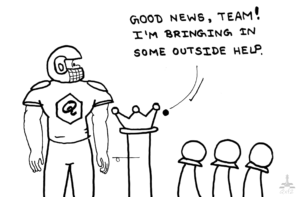This post will give you an overview of how we think about team structure and job roles at Qxf2. We are fairly certain that current structure of testing teams is not going to help us solve a lot of problems that are coming our way. You can read about the challenges we think are coming our way.

Haven’t you already felt the pinch?
Most testers have already felt the need for DevOps. With AI and Machine Learning becoming more prevalent, we will need mathematics. Most electronic devices we use are going to become smart and so knowing a bit of hardware is good. We lack tools to observe, probe and exercise AI and hardware. So we will also need outside help from developers to build some useful tools for us. Another important thing that will happen to testing is that we will be overwhelmed with the amount of information we are observing and reporting. Using only text to summarize our findings will not be enough. We will be pushed to summarize our work and findings in more visual and interactive ways. So having an eye for UI design is going to be needed.
So what is the problem?
No one person can be expected to be good at all of this! Testing is going to become a multi-disciplinary problem. Testers are going to have to interact with a variety of professions and professionals who have never before interacted with a QA team in their life. We need to learn to lobby for their time, make sure we are communicating our needs effectively, learn new vocabulary to exchange ideas and figure out how to give good feedback. The days of just interacting only with a product manager and developers (and maybe some support staff) are numbered. This is going to be a huge cultural change for the testing community. We need to learn new work habits and work patterns.
Working with freelancers for non-testing expertise

At Qxf2, we want to practice working with a wide range of professions and learn to communicate effectively with other job roles. We are doing this by experimenting with our hiring and team structures. For now, we plan to hire short-term contractors and a wide range of freelancers. By keeping contracts short and hiring freelancers, we are reducing the risk of us failing. We know there is a steep learning curve when testers have to engage with roles that they have not traditionally worked with before. But hiring freelancers will help us get used to working with different, non-traditional, job roles. It will also help us form a network early.
We already work with an illustrator. We make use of him in some places. But we think we can do much better. Most testers at Qxf2 are not looking at him as a resource to help them communicate their testing ideas better. We think that is because they are not used to having such a role help them in their previous jobs and so they do not even think about how they can utilize the illustrator’s expertise. And even if they do think of images they want, they (and the illustrator) struggle to communicate in a way that both sides understand the ask. Oh, well! It is a start.
A safe-to-fail canvas to interact
Based on our experience with trying to integrate an illustrator in our workflow, we figured that we need a canvas for people to interact with these job roles on a daily basis before relying on their expertise becomes a habit. So for now, we have identified a couple of projects that we will try out new team compositions. We are (trying to) forming two cross-functional teams for two projects:
a) a book
b) an intelligent JIRA dashboard for QA professionals
We will be looking for editors, storytellers, graphic artists, DevOps engineers, developers and marketers to work with. I bet we will stumble the first few times we try this experiment. But I have hopes that eventually we will get it right and we will have also formed a network that will eventually help us.
We are choosing to work on real projects because … well, because they will eventually be useful. We are ok with these projects taking unusually long times because having the team gel and work with other job roles is one of the important side-effects that we are looking forward to.
Our expectation
We are pretty new to this. So we cannot really act like experts and predict what is to follow. But for now, we think the biggest challenges we are going to have is in managing expectations on both sides. Our testers are going to assume the other job roles can run with really high-level instructions. Our non-testers are going to be expecting exact instructions and more involvement from our testers. We don’t know how to solve this, but we hope that time will make things better.
Do you know talented freelancers? If so, let them know Qxf2 is on the hunt for short-term contractors. We are looking for editors, writers, DevOps engineers, JavaScript developers, data visualization experts, etc.
Related posts
- Where is Qxf2 headed?
- The need for change (at Qxf2)
- An introduction to R&D at Qxf2
- Qxf2’s DevOps roadmap
- Qxf2’s Hardware and Robotics roadmap
- Qxf2’s Data analytics, Machine Learning and AI roadmap
- An introduction to training at Qxf2
- An introduction to hiring and onboarding at Qxf2
- Experimenting with team structures at Qxf2
I want to find out what conditions produce remarkable software. A few years ago, I chose to work as the first professional tester at a startup. I successfully won credibility for testers and established a world-class team. I have lead the testing for early versions of multiple products. Today, I run Qxf2 Services. Qxf2 provides software testing services for startups. If you are interested in what Qxf2 offers or simply want to talk about testing, you can contact me at: [email protected]. I like testing, math, chess and dogs.
